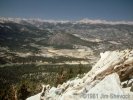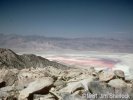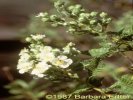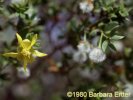 Carl Purpus, Plant Collector in
Western America
Carl Purpus, Plant Collector in
Western America 
Carl A. Purpus Translation by Barbara
Ertter






|
Original Title Bericht uber meine diesjahrige Sammeltour durch die sudostliche Sierra Nevada von Californien Von C. A. Purpus. Daunt Tulare Co. Calif. Mitt. Deutsch. Dendrol. Ges. 5: 229-235.
|  View from
Olancha Peak, California. View from
Olancha Peak, California. Locations: Monachy Meadows. Olancha Peak.
We camped here for several days and then continued our travels to Monachy Meadows [this would have to be Strawberry Meadows, judging from its relation to Olancha Peak]. To the southeast rose the 12,225 [12,123] feet high Olancha Peak, which I had thought to explore. More new shrubs appeared here, e.g. Artemisia rothrockii A. Gray, which bordered grassy areas in many places in association with A. tridentata. On the slopes of the mountain grew Castanopsis, Jamesia americana, assorted handsome shrubby Eriogonum, Gutierrezia, Bigelowia, Tetradymia, Cercocarpus ledifolius, and Sambucus melanocarpa?. I also found a Lonicera with violet berries that might possibly be a form of L. coerulea L.
|
|  Owens Lake from Olancha Peak, California.
Owens Lake from Olancha Peak, California.
Locations: Owens River Lake. Owens River Valley. I climbed Olancha Peak and had a
fantastic view overlooking the Owens River Valley with the
deep blue Owens River Lake. On the way up I found a silvery white small-leaved variety of Artemisia tridentata, as well as Cercocarpus ledifolius, Ribes cereum, Jamesia americana, Bigelowia, and others. On rocks in the alpine zone halfway up the mountain grew the interesting Tanacetum canum and a Penstemon with large magnificent violet flowers.
|
| We stayed at the base
of the mountain for several days and then set out for the Owens River Valley on the continuation of our travels. This journey was very interesting, over a trail that led partly through meadows, partly over low mountains that often reached the respectable height of 9-10,000 feet. Masses of Cercocarpus ledifolius grew on the slopes. The forests consisted mostly of Pinus murrayana, which extends to the eastern slopes of the Sierra, where it is replaced at 7000 feet by Pinus monophylla Torr. & Frem. Here it forms the forests in association with Abies concolor, which, however, only occurs along the streams.
|
|  Chamaebatiaria millefolium.
Chamaebatiaria millefolium.  Chamaebatiaria millefolium.
Chamaebatiaria millefolium.
Locations: Cottonwood Creek Canyon. We stopped for several days on the
edge of a beautiful grassy area, then continued to Cottonwood Creek Canyon, so named because of the masses of cottonwoods that have colonized its banks. Populus trichocarpa grows in the upper parts, P. fremontii S. Wats. in the lower. The leaves of P. trichocarpa here vary greatly, and are often small and nearly oblanceolate like those of P. angustifolia James. At first the shrubs were the same as those already frequently mentioned. Ascending somewhat higher, some 100 feet below the typical Pinus murrayna zone, which often occurs here at 7000 feet, I found the incomparable Chamaebatiaria millefolium Max., not to be confused with Chamaebatia foliolosa Benth., which belongs to an entirely different group. It was covered with flowers and grew on cliffs or rocky slopes of granite. I was surprised by this unexpected sight, for what I had known as a low shrub was now a stately specimen 4-6 feet tall.
|
| I was even more
astonished and delighted here to find a magnificent dark red-flowered Opuntia
with fine yellow spine clusters, similar to the elegant O. microdasys, growing on granite cliffs and rocks. It was covered with flowers, creating an enchanting picture. The cactus would be
completely winter-hardy in Germany. Plants from the east side of the Sierra Nevada are naturally
hardier than those from the west side, because the climate is completely different and much harsher.
The winters are cold even in the valleys, where the thermometer drops to 2 degrees Fahrenheit and
probably even lower. Plants collected at 5000 feet are surely winter-hardy in Germany, and even
those from much lower places may endure.
|
| Somewhat lower down
[Cottonwood Creek Canyon], I found a stiffly thorned Ribes with
silver-white bark, then a small-leaved form of Acer glabrum Torr., a shrubby lupine, shrubby Galium and Eriogonum, various Bigelowia, Arctostaphylos sp., masses of Betula occidentalis Hook., Ephedra nevadensis S. Wats. or E. viridis, and a very interesting Purshia that I took for P. glandulosa.
|
|  Larrea tridentata.
Larrea tridentata.  Owens Lake from Olancha Peak, California.
Owens Lake from Olancha Peak, California.
Other Articles: On the Trail…: 0240 Locations: Owens River Valley. Letters: 10/27/1896
After resting for several days, we climbed through [left?] the canyon and entered the very interesting
Owens River Valley with its alkaline lake. The region had a desert aspect. Trees occurred only along the creeks and included Populus fremontii, Fraxinus coriacea S. Wats., and willows. The abundance of shrubs, however, was utterly amazing. Chenopodiaceae and Artemisia tridentata formed the dominant vegetation, interspersed with shrubby Eriogonum and Compositae. The highly interesting [fascinating?] Dalea fremontii Torr. & Gray occurred in great abundance in sandy places, growing as low, pleasantly aromatic shrubs with sharply bent branches. Also there were Dalea polydenia Torr., a tall shrub-like Opuntia sp., and an abundance of shrubs that were new to me. On stony, gentle slopes at the foot of a steeply inclined moutain, I found the intriguing Larrea tridentata, a Zygophyllaceae covered with small white-haired fruits. This shrub is without doubt the most interesting in western North America.
| |
[Previous Page] [Next Page] | |
| [Published Biographies] [Travelogues and Articles] [Letters] [Plant Lists and Bibliography] [Site Administration] | | Date and time this article was prepared: 6/7/2002 7:32:09 PM |